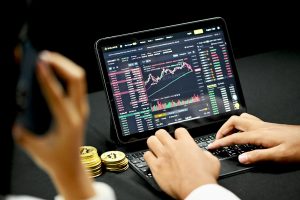Did you know 95% of forex traders lose their money while trading? It’s because of their poor risk management skills. That is why it is important to adopt and learn risk management strategies for Forex. Entering into the forex market and starting a trade is pretty easy. However, managing risks and potential losses is a hard nut to crack.
Forex is often risky, especially for beginners. Therefore, it is essential for all types of traders to learn risk management. Risk management in forex trading might be complex to understand, although this article solves all the doubts.
This article will discuss nitty-gritty details about risk management, benefits, and vital strategies. Without further ado, let’s dive into it.
What is Risk Management in Forex Trading?
Risk Management refers to the set of strategies and tactics that traders employ to minimize the potential losses during their trades. Forex is one of the most volatile markets because of currency fluctuations on a daily basis, which makes it risky for beginners to start trading.
Moreover, taking risks is good as it can result in more profit; however, if the market doesn’t go in your favor, it may result in significant losses. Risk management means following a set of rules, applying different techniques and strategies, and learning about market conditions for minimum losses.
What are the Common Risks in Forex Trading?
Here is the list of common Risks in Forex Trading:
Market Volatility
Market volatility is the rudimentary risk in Forex trading. The prices of the foreign currency pairs are affected by political instability or economic issues, which may results in potential losses. You can mitigate these risks by learning proper risk management strategies.
Liquidity Risk
These are some of the fundamental risks in forex trading, which refers to not being able to buy a certain currency pair at a desired price due to low trading volume. It can be solved with proper risk management skills.
Counterparty Risk
Counterparty risks refer to the broker you’ve chosen to open trades. It is better to find a reputable broker for trading foreign currencies.
Forex Market Volatility
Forex volatility risk, often simply referred to as “volatility risk” in the context of forex trading, is the risk associated with the potential for significant and rapid price fluctuations in the foreign exchange (forex) market. Volatility risk arises due to the inherent uncertainty and dynamic nature of currency exchange rates.
Strategies to Manage Risk in Forex Trading
Learn about Risk Management
As we all know, Forex is a huge market, with daily updates about currencies, trends, and more. Therefore, as a beginner, it is indispensable for you to learn risk management.
You can learn different technical analysis tools, strategies, and indicators for forex trading to better manage your trades. You can also read our guide about Forex trading to learn different strategies and tips.
Employ Stop Loss And Take Profit
Stop loss and Take profit are two more essential ways to handle risks in forex trading. Most professional traders implement these to avoid potential losses and generate more profit while trading in their desired markets.
Stop loss serves as an order, where you pre-determined a certain value to your broker to automatically close your trade (buy or sell) when the market goes against it. While writing this, the current price of EUR/USD is 1.069. Suppose you have entered a buy position and can’t afford to lose if the price goes below 1.065. Therefore, you can set the stop loss at 1.065, and the trade will be automatically closed if the market reaches this value, preventing further losses.
As the name suggests, Take Profits is an order you place with your broker to automatically close a position (buy or sell) when the market reaches a specific price level that you’ve pre-determined and bank the profit. It is similar to stop loss but has a different concept.
Don’t Take High Leverage
Taking leverage gives you exposure to open high trades in forex trading. It is a basic concept in forex trading, and it gives traders the power to open large positions with small investments. It is generally represented in ratios such as 2:1, 3:1, or any. If your account has the leverage of 2:20, it means you can open a trade worth $20,000 with only $2,000 in your account.
Moreover, it is a great way to make profits on Forex. Leverage magnifies both profits and losses. Therefore it is better for beginner traders to limit leverage. Once you have a clear concept of trading, you can take advantage of higher leverage and make profits.
It’s important to prioritize risk management to sustain a trading career over the long term. High leverage can hinder long-term sustainability because it increases the chances of significant capital drawdowns that are difficult to recover from.
Suitable Position Size of the Trades
Position size in forex trading refers to the number of lots or units a trader invests in a currency pair. It is a crucial aspect of risk management and determines the amount of risk and potential profit associated with a trade. As a beginner trader, we advise you to reckon small lots when trading forex currency pairs, as this market is quite volatile.
It is a vital component in risk management, and traders can minimize their potential losses by adjusting the right position size of the trade. It also helps you to diversify your trades. You can easily calculate your position size on MyFXbook.com!
Learn and Take Advantage of Technical Indicators
Technical indicators such as moving averages, pivot lines, and Bollinger bands are popular technical analysis tools for forex trading. Technical indicators help traders understand the trading charts and make informed trading decisions.
Moreover, technical analysis also allows traders to identify market trends such as downtrend, uptrend, and sideways. Following the right trend can avoid potential losses and enhance your risk management skills.
Technical analysis tools can assist in determining favorable risk-reward ratios for trades. By identifying potential support and resistance levels, traders can calculate how much they stand to gain compared to what they are risking in each trade. This information helps in selecting trades with more favorable risk-reward profiles.
Plan Ahead Your Trades
Once you understand the market, planning ahead before opening any trade on the Forex market is better. As we have mentioned, Forex is risky, and the market will not always go in your favor. Therefore, analyze the markets in which you are going to open trade, read the recent news, look for any updates about political issues, and follow smart traders.
Furthermore, you should also not depend on one market. Forex has 28+ minor and major currency pairs, and every market is different. Additionally, you practice in a demo account before opening any live trades.
Find a Trustworthy Trader
It is also vital for risk management in forex trading. Shenanigan activities from brokers can often affect your trades, so it’s crucial to find and consult the best broker available. There are many factors to consider before consulting the right broker, such as customer service, commission, spreads, and fees.
You can easily mitigate the risks by choosing a broker with a good reputation and customer reviews and consulting them.
Benefits of Risk Management
Better Understanding of the Market
Risk management helps you to understand the forex market and make the right trading decisions. Moreover, risk management techniques and strategies encourage you to employ technical analysis of the markets, which results in a better understanding and fewer losses in Forex.
Long-term Profits
Effective risk management can enhance your chances of long-term profitability. By limiting losses, you ensure that your winning trades have a more substantial impact on your overall account balance. Over time, this can lead to consistent profits.
Saves Money
By employing proper risk management strategies, you can save money and limit your losses while trading in your desired forex market. It helps you stick to a well-thought-out trading plan, preventing erratic or impulsive behavior that can lead to losses. Consistency is essential for long-term success.
No Headaches
Proper risk management helps you get rid of the stresses that are associated with forex trading. Therefore, you can make rational and objective decisions.
Conclusion
Risk management in forex trading is one of the core skills to learn to trade better and minimize losses. You can read blogs and news, watch webinars, and practice to learn about risk management. The above section describes the benefits and core strategies to mitigate risks in forex trading.





